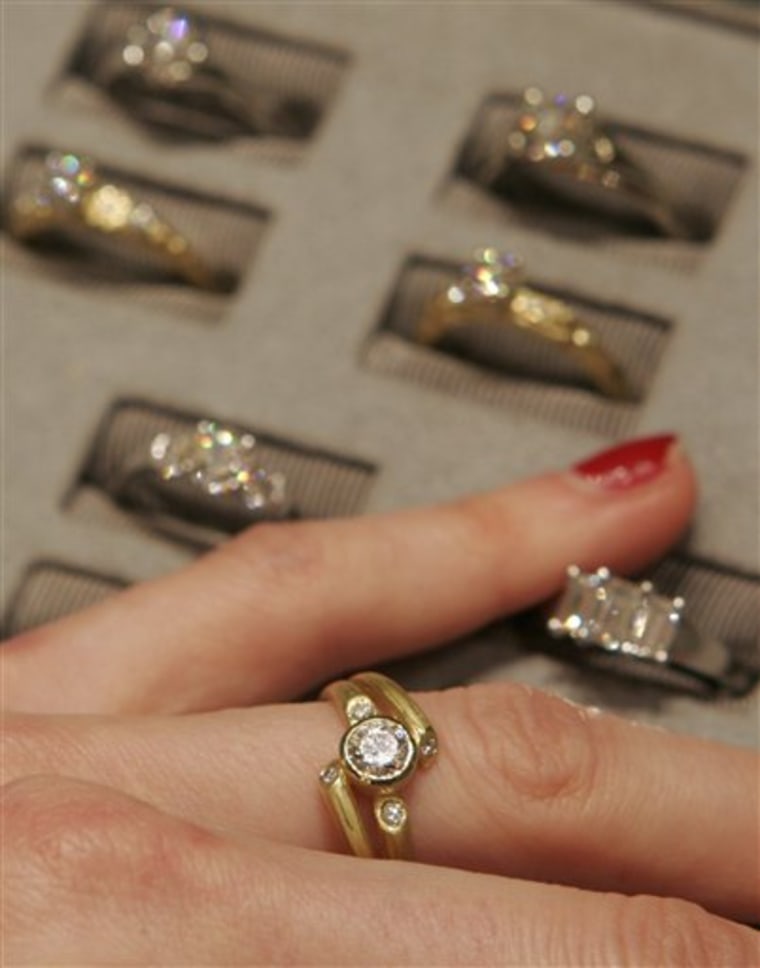This holiday season some diamond retailers say they are seeing heightened consumer concern about conflict diamonds, the gems mined in war zones that are sold to fund armed conflict and civil war.
Sales of so-called conflict diamonds have helped finance wars that killed millions in Angola, Congo, Sierra Leone and Liberia over the past several decades, and efforts to address the problem have been made within the diamond industry.
But human rights groups are now taking the issue straight to consumers, and with Friday's release of Warner Bros. Pictures' new film "Blood Diamond," diamond retailers are preparing to face more scrutiny than ever before.
Many large retailers, like Tiffany & Co. and Zale Corp., say they have enacted policies to help stem the flow of conflict diamonds. And during the all-important holiday season, when at least half of annual jewelry sales are recorded, retailers want their customers to feel they can shop guilt-free.
They are being assisted in this effort by a $15 million marketing campaign launched ahead of the holidays by the World Diamond Council, which wants potential diamond buyers to understand the movie's premise takes place prior to the Kimberley Process Certification Scheme, which was enacted by governments, non-governmental organizations and the industry in 2002 to track diamonds from mine to jewelry display case, certifying each stone's origin. The film, starring Leonardo DiCaprio and Jennifer Connelly, takes place during the civil war in Sierra Leone in the 1990's.
The industry group took out full-page ads in national newspapers, created the Web site diamondfacts.org to disseminate information, and provided retailers with training pamphlets on the topic.
David Sternblitz, vice president and treasurer for Zale Corp., said Zale abides by the Kimberley Process, buying stones only from those 45 nations that participate in Kimberley, which account for about 99.8 percent of global production of rough diamonds.
Sternblitz says customers can find information outlining Zale's policy on conflict-free diamonds on its Web site.
"This is something that hasn't been new to us," Sternblitz says. "Since the Kimberley Process in 2002, we've required all suppliers to warranty to us that diamonds are coming from conflict-free areas."
Tiffany & Co. also says it buys diamonds from legitimate miners and doesn't purchase diamonds for cash or in circumstances where the source of the diamond is questionable.
Smaller retailers are aware of the growing interest, too.
"At least one customer a day asks us about it," said Jennie Fiske, who manages The Clay Pot, a Brooklyn, N.Y.-based jewelry retailer. "Over the years, it's become more and more well-known."
Fiske says she's been aware of the issue since 2000 and reassures customers that it's highly unlikely they are getting a conflict gem, since her suppliers buy diamonds through legitimate sources.
For customers who want to know where their gems come from, The Clay Pot also offers guaranteed conflict-free diamonds from Canada. The diamonds are mined, cut and polished in Canada's Northwest Territories and are certified by the Northwest Territories Government Monitoring and Certification program, which tracks each diamond from the mining stage to the final cutting process.
"There's been an increasing popularity for them," Fiske said, noting that sales of the Canadian stones make up about 20 percent of total diamond purchases.
Despite their notorious reputation, less than 1 percent of the world's diamonds are conflict diamonds, says the World Diamond Council.
Still, some human rights organizations assert there needs to be more regulation in the U.S., which accounts for more than half of global diamond jewelry retail sales, according to British rights group Global Witness.
A 2004 survey of diamond jewelers conducted by Amnesty International and Global Witness showed only 11 percent of stores visited in the U.S. said they had a policy on conflict diamonds, and 67 percent were unwilling to discuss whether they had a system of guarantees in place.
Charmian Gooch, executive director of Global Witness, said the Kimberley Process needs more work.
"It's still full of loopholes," Gooch said. "There's no proper oversight and no clear way to know how the industry is controlling it across the board."
Amy O'Meara, a spokeswoman for Amnesty International, suggests consumers take an active role in the process by asking jewelers where their diamonds come from, since even the smaller percentages of illegal diamonds need to be eliminated.
"Ask to see a written guarantee that its suppliers are conflict-free," O'Meara said. "No amount of human suffering is acceptable to turn a profit."
